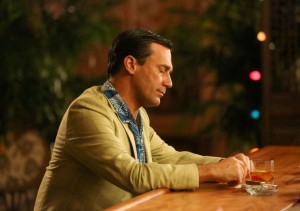Death pervades Mad Men season opener
From the start, the two-hour season premiere of Mad Men on Sunday establishes an ominous mood, as Don Draper quotes from Dante’s Inferno.

Piano man · Don Draper (Jon Hamm) stays preoccupied with death during the premiere of Mad Men. His dark mood hangs over the episode. – Courtesy of Michael Yarish
“Midway in our life’s journey, I went astray from the straight road, and woke up to find myself in a dark wood,” Don reads, setting the scene for the dark mood the episode carries, unprecedented to previous season-openers. Because of this, instead of promising a sense of renewal, “The Doorway” seems to reflect a continuous internal melancholy within the show’s characters — especially Don.
Perhaps Lane Pryce’s suicide last season is one of the reasons that anxious thoughts about death seem to underline Sunday night’s episode.
Death predominantly affected Don’s behavior throughout the episode, as his demeanor was disturbingly removed and unfocused. He seemed to be more interested in reading Inferno than in enjoying his luxurious expenses-paid Hawaiian vacation. Don’s compulsiveness about death might hopefully resolve the series’ fundamental question — Who is Don Draper?
One of the salient narrative techniques in “The Doorway” is that it is not designed to look like a season opener. Rather, it is a continuation. A possible lack of a concrete narrative might be a primary reason why some viewers find Mad Men a challenging experience. Though Weiner’s plot structures might articulate as puzzling, they nonetheless, translate into an hour of beautiful television.
For Mad Men to explain its details, such as an exact year, would significantly detract from its intoxicating experience. Ambiguity of an exact year became a major narrative approach in the fifth season, only to be revealed in subtle dialogue or visual indicators (the fifth season left off in spring 1967, as Don paid a visit to the cinema to watch Casino Royale). Viewing Mad Men is learning how to sharply train your eye to pick up details. “The Doorway” clearly was an example of this narrative tactic.
“The Doorway” was loaded with from past seasons iconography. Outrageous fashions of the late ’60s and the addition of a staircase leading to the newly constructed second floor at Sterling Cooper Draper Pryce comprised minor details of the episode. Instead of investigating possible new meanings to these striking images, recycling of previous seasons’ symbols was of higher significance.
Finely pressed suits, cigarettes and Don’s Old Fashioned provide hints at character development. Don’s indulgences with his signature cocktail and handy cigarette were crucial in revealing his affair with his neighbor, breaking fidelity with Megan.
A slimmer Betty continued donning her brown-tweed suit and Hermes scarf, still indicating discomfort with her figure. Betty’s unexpected decision to dye her blonde locks darker might further encourage her to shed the extra weight.
The most sentimental re-use of earlier props was the use of the Kodak Carousel. At the Drapers’ New Year’s Eve party, Megan showed guests pictures of their luxurious Hawaiian vacation using the slide projector. The Kodak Carousel was pitched in the Mad Men’s first season finale, when Don poignantly immortalized, “In Greek, nostalgia literally means ‘the pain from an old wound.’”
Absent-mindedness, frequent death haunts, binge drinking and smoking contributed to Don’s obvious dissatisfaction with his current life and marriage. As Don exits the honeymoon phase, viewers are left conjecturing whether Don will revisit his old philandering habits.
Similar to some other Mad Men episodes, “The Doorway” could be burdensome because of its slowly paced narrative and tendency to assimilate multiple plotlines within an episode. Nonetheless, the episode successfully reclaimed focus of its primary characters: Don, Betty, Peggy and Roger. “The Doorway” splits time between them, all recomposed with new attitudes.
It is gratifying to see Peggy succeed as copy chief at her new agency, especially when handling a potential crisis with a client. Peggy’s copywriting talent and intelligent problem-solving skills confirm her to be a true Don Draper protege. But Peggy’s creative director enthusiastically commends her ethic — a contrast to Don’s habitual indifference toward her achievements.
Roger functioned as the comedic relief among the other characters. But sharing time between his mother’s funeral and a visit to his psychiatrist, Roger was part of a darker narrative as he refused to acknowledge the seriousness of his health problems.
Regardless of the show’s outcome, Mad Men is one of television’s best shows. Much critical acclaim is indebted to the confidence of Weiner’s writing team and their capability to enhance their product on a yearly basis. And Mad Men has become a high-water mark on Sunday night television and pop culture at large, allowing its writers to divulge in deeper and more cryptic situations.
Much of the show’s richness depends on its openness for various interpretations, as it uses a significant decade of American history as milieu.
As the episode ends on New Year’s Day 1968, a major unanswered question has been whether the series will end within the decade.
Costumes, however, might hold clues, as they act as primary indicators that designate time. Several male characters have ridiculous beards and moustaches, while the women don tighter and brighter fashions.
Weiner and his writing team are well-aware of the anticipation that many viewers hold and this tactic might come into play as an underlying tease throughout the season, as the show changes to fit the transition into a new decade — the seventies.
